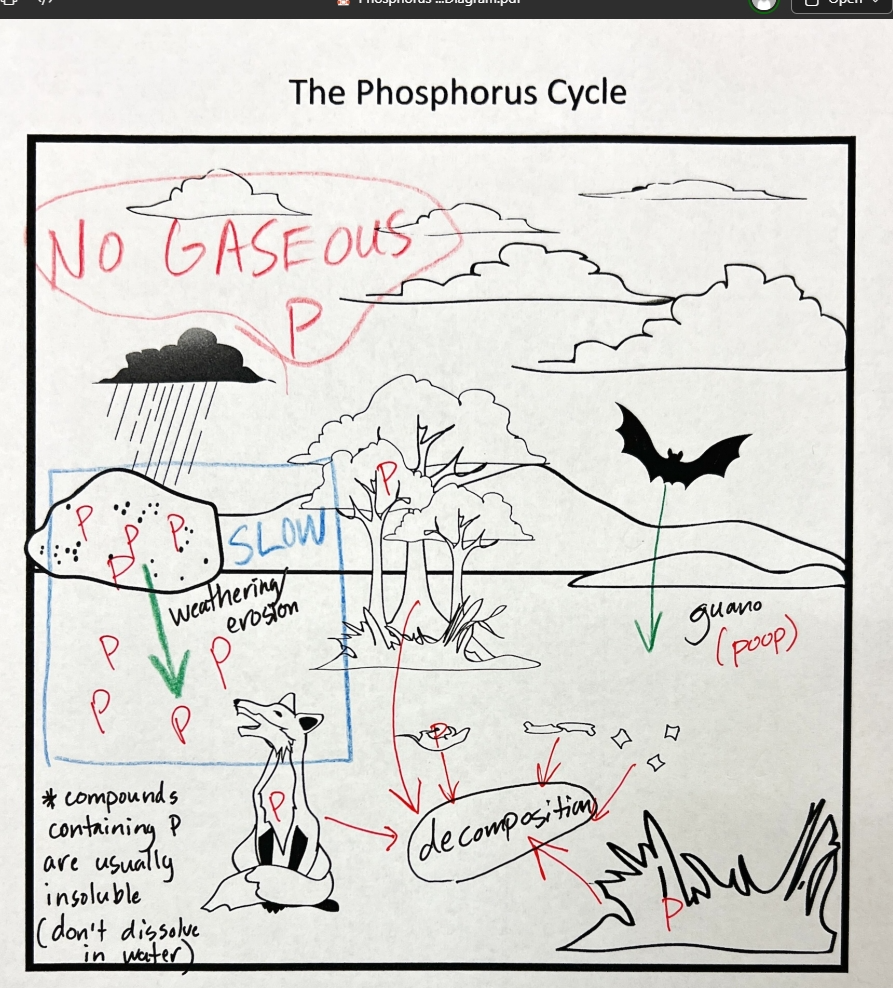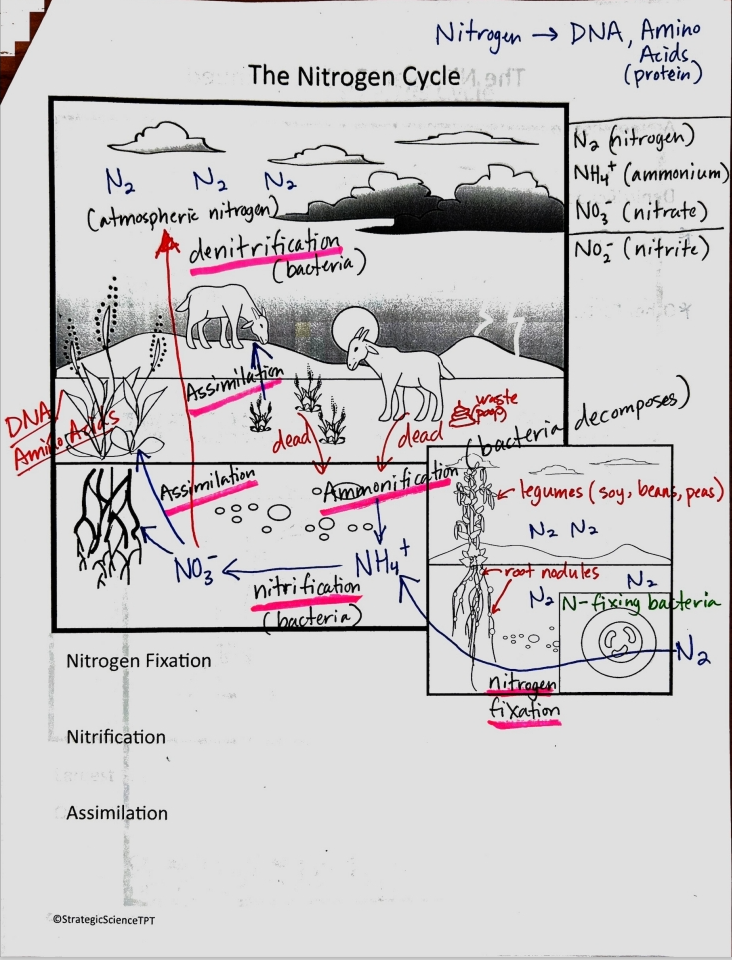APES Unit 1
1/86
Earn XP
Name | Mastery | Learn | Test | Matching | Spaced |
|---|
No study sessions yet.
87 Terms
temperate seasonal/deciduous forest
Major locations: Europe, Eastern China, Eastern North America, Great Lakes
Climate: warm summers, cold winters w/ freeze Rainfall: high precipitation throughout the year
Soil nutrients: high nutrients- warm summers, temp. results in rapid decomposition of leaves that fall in winter
Other: features - leaves fall off trees which decompose and make soil fertile
Temperate grassland
Major locations: North American Plains (prairie), Russia (steppe)
Climate: rainfall: limited support, more grasses than trees extremes: very cold in winter, hot in summer
Soil nutrients: topsoil formed from thousands of years of herbivore waste (buffalo) & grass decomposition; high nutrients - long growing season, rapid decomposition of grass during warm months + adds nutrients
Other: very little of the biome remains as most has turned into agriculture due to excellent topsoil
Temperate Rainforest
Major locations: Pacific Northwest of U.S, S. Alaska Japan
Climate: mild temp. year-round rainfall - abundant
Soil nutrients: low nutrients - cooler temp. = slower decomposition released nutrients are quickly taken up by many trees/leached further down in soil due to rain
Other: parts ae old growth & important for biodiversity, commercially important for logging
Tropical rainforest
Major locations: equatorial on most continents
Climate: hot year-round Rainfall: Abundant year round
Soil nutrients: low nutrients - rapid decomposition, but high levels of plant growth result in nutrients taken up quickly leaving low level of nutrients in the soil \
Other: highest biodiversity on land dark, damp, Lush
Savanna
Major locations: mainly Africa
Climate: warm year-round Rainfall: low overall, has rainy season
Soil nutrients: high nutrients - rapid decomposition due to warm temp., not much rain results in plants using less nutrients from the soil
Other: grasses dominate due to limited rainfall has large acacia trees
Desert
Major locations: mainly places globally around 30N & 30S latitude
Climate: extremes b/w winter (very cold) and summer (very hot) rainfall: very low
Soil Nutrients: not much organic matter to decompose & dry
Other: organisms are specialized to survive. some desserts are barren w/ sand dunes while others have drought resistant shrubs.
Tundra
Major locations: high altitudes surrounding the poles - Artic and Antarctic
Climate: very cold → snow +ice in winter, summer looks barren buts its vegetation is important Rainfall: very low
Soil Nutrients: decomposition occurs slowly due to cold temp. resulting on low level of nutrients
Other: Little daylight in winter. Lots of daylight in summer which leads to abundant productivity (photosynthesis). Important for migratory animals in summer. Has permafrost soil that is melting with climate change
Taiga/ Boreal Forest
Major locations: Canada, Russia, Alaska. Scandinavia, very high altitudes in mountains of other biomes
Climate: very cold winters & mild summers Rainfall: moderate
Soil Nutrients: decomposition occurs slowly due to cold temperatures resulting in low level of nutrients
Other: Conifer and Evergreen trees (like Christmas trees). Animals hibernate and then feed abundantly during summers
Shrubland/ Chaparral
Major locations: Southern California, Mediterranean, Chile, Australia
Rainfall: Low, but more than desert. Only biome with almost no rain in summer. Climate: Hot summers, mild winters
Soil: Low nutrients – due to leaching of soil nutrients during rainy winter
Other: has evergreen shrubs, adapted to & dependent on fire
True or False?
Biomes are determined by temp. and precipitation, certain regions on earth
True
What two main factors that determine climate and therefore plant growth?
Temperature and precipitation
hydrologic cycle
evaporation
transpiration
condensation
precipitation
runoff
seepage/infiltration
groundwater/aquifer
evaporation
water turns from liquid to gas (vapor)
transpiration
process plants use to draw groundwater from roots up to their leaves
infiltration
water moves through surface of soil
surface run off
the path precipitation takes to streams, rivers, lakes, and the ocean
aquifers
water stored underground
precipitation
water falling from the atmosphere to land (rain, snow, ice, sleet)
condensation
water vapor creates clouds in the atmosphere
What are the major sinks (reservoirs) for each biogeochemical cycle?
hydrologic (water) cycle = oceans
carbon cycle = sedimentary rocks & sediments at the bottom of the ocean
nitrogen cycle = atmosphere
phosphorus cycle = sedimentary rocks
Carbon cycle
photosynthesis
cellular respiration
deforestation
burning fossil fuels
ocean acidification → Excess CO2 is absorbed by ocean water and creates carbonic acid. This lowers water pH and damages the shells of species such as coral and mussels
Which biogeochemical cycle doesn’t contain a gaseous phase?
Phosphorus cycle
Phosphorus cycle

Draw a simple nitrogen cycle including the following terms and molecules. Ammonification, nitrification, denitrification, nitrogen fixation, assimilation, N2, NH4+, NO3-, DNA/amino acids, and label where bacteria take part in the process

N2
nitrogen
N03-
nitrate
NO2-
nitrite
NH4+
Ammonium
Describe the role legumes in the nitrogen cycle including the term root nodule.
Legumes have root nodules that contain nitrogen-fixing bacteria. This type of bacteria converts nitrogen (N2) to ammonium (NH4+). This process is known as nitrogen fixation.
they convert atmospheric nitrogen into nitrogen available for use by other organisms
What are ways carbon dioxide is taken out of the atmosphere and put back into the atmosphere?
Taken out: photosynthesis, ocean acidification
put back in: combustion, cellular respiration
What are the reactants and products for photosynthesis?
CO2+ H2O + sun = O2 + C6 H12 O6
What are the reactants and products for cellular respiration?
O2 + C6 H12 O6 = CO2+ H2O + ATP
resource partitioning
different species using the same resource in diff. ways to reduce competition
Temporal partitioning
using resource @ different times, such as wolves & coyotes hunting @ different times (night vs. day)
Spatial partitioning
using diff. areas of a shared habitat (diff. length roots)
Morphological partitioning
using different resources based on different evolved body features
abiotic
physical rather than biological; not derived from living organisms
biotic
relating to or resulting from living things, especially in their ecological relations
parasitism
a type of symbiotic relationship where one species, the parasite, benefits at the expense of another species, the host
mutualism
Organisms of diff. species living close together in a way that benefits both species
commensalism
relationship that benefits one organism & doesn’t impact the other (birds nest in trees)
competition
organisms fighting over a resource like food or shelter; limits pop. size
predation
one organism using another for energy source (hunters, parasites, even herbivores)
intra-specific competition
an interaction where members of same species compete for limited resource
inter-specific competition
competition between different species
biome
large area with similar climate conditions that determine plant & animal species there
Ex: (tropical rainforest)
ecosystem
all living & nonliving things in an area (plants, animals, rocks, soil, water, air)
community
all living organisms in an area
population
group of individuals of same species (elk herd)
individual
one organism
Why is phosphorus considered a limiting factor in ecosystems?
Because the quantities of phosphorus are generally small, it limits plant growth
There is not a gaseous phase of the phosphorus cycle, and therefore the movement of phosphorus into oceanic reservoirs is very slow.
Out of the four biogeochemical cycles, which two play a role in providing important soil nutrients to plants?
Phosphorus and nitrogen cycle
littoral
zone of a lake
hallow water w/emergent plants
limnetic
zone of a lake
where light can reach (Photosynth)
No rooted plants, only phytoplankton
profundal
zone of a lake
too deep for sunlight (no photosynthesis)
benthic
zone of a lake
murky bottom where invertebrates (bugs) live, nutrient-rich sediments
intertidal/coastal
zone of the ocean
Narrow band of coastline between high & low tide
Organisms must be adapted to survive crashing waves & direct sunlight/heat during low tide
lakes/ponds
freshwater biome
lake = standing bodies of fresh H2O (key drinking H2O source)
rivers/streams
freshwater biome
Rivers have high O2 due to flow mixing water & air, also carry nutrient-rich sediments (deltas & flood plains = fertile soil)
inland wetlands
freshwater biome
wetland - area with soil submerged/saturated in water for at least part of the year, but shallow enough for emergent plants
estuaries/salt marshes
marine/saltwater biome
areas where rivers empty into the ocean
Mix of fresh & salt water (species adapt to this ex: mangrove trees)
High productivity (plant growth) due to nutrients in sediments deposited in estuaries by river
coral reef
marine/saltwater biome
Warm shallow waters beyond the shoreline; most diverse marine (ocean) biome on earth
Mutualistic relationship between coral (animals) & algae (plants)
open ocean
marine/saltwater biome
Low productivity/area as only algae & phytoplankton can survive in most of ocean
So large though, that algae & phytoplankton of ocean produce a lot of earth’s O2 & absorb a lot of atmospheric CO2
photic zone
area where sunlight can reach (photosynthesis)
(typically, ocean)
aphotic zone (abyssal)
area too deep for sunlight
zone of the ocean
What are the levels of organization in a biome from largest to smallest?
biosphere, biome, ecosystem, community, population, species, and organism.
10% rule for energy transfer in food chains
about 10 percent of energy stored as biomass in a trophic level is passed from one level to the next
How do 1st and 2nd law of thermodynamics apply to energy transfer in a food chain?
1st law of thermodynamics = energy is never created or destroyed, its transferred
2nd law of thermodynamics = each time energy is transferred, some of it is lost as heat (10% rule)
lost = unusable
energy pyramid
graphical representation, showing the flow of energy at each trophic level in an ecosystem
biomass pyramid
graphical representation of biomass present in a unit area of various trophic levels
It shows the relationship between biomass and trophic level quantifying the biomass available in each trophic level of an energy community at a given time.
Why are energy/biomass pyramids so small at the top?
Each higher level in the pyramid gets smaller (the bars get narrower) because only about 10% of the available energy transfers to the next level.
GPP
gross primary production; The total amount of sun energy (light) that plants capture and convert to energy (glucose) through photosynthesis
NPP
net primary production; GPP - R
the rate at which energy is stored as biomass by plants or other primary producers and made available to the consumers in the ecosystem
R
respiration/respiration loss (cellular respiration); plants use up some of the energy they generate via photosynthesis by doing cell. respiration (movement, internal transportation, etc.
Formula for NPP
NPP = GPP - R
Producers
an organism that produces organic compounds from simple substances such as water and carbon dioxide; an autotroph
primary consumers
organism that feeds on primary producers
2nd trophic level
secondary consumers
Feed on primary consumers (herbivores).
Occupy the third trophic level in a food chain.
Can be either carnivores (eating other animals) or omnivores (consuming both animal and plant matter).
tertiary consumers
animal that obtains its nutrition by eating primary consumers and secondary consumers (omnivore/carnivore)
scavengers
animal that feeds partly or wholly on the bodies of dead animals
detritivores
heterotrophs that obtain nutrients by consuming detritus (decomposing plant and animal parts as well as feces).
decomposers
organism that decomposes, or breaks down, organic material such as the remains of dead organisms
heterotrophs
cannot produce its own food and instead relies on other sources of organic carbon, mainly plant or animal matter
autotrophs
can produce its own food using light, water, carbon dioxide, or other chemicals
Understand the effects of eliminating a species in a food chain.
Example: What would happen to the other species (increase or decrease?) if the desert fox was overhunted and eliminated?
Cacti → Kangaroo rats → snakes → desert fox
If the desert fox was overhunted/eliminated, the snake population would increase as would cacti. The kangaroo rat’s population would decrease.
ecological footprint
measured in land (gha = global hectare)
measure oif how much a person/group consumes, expressed in area of land
carbon footprint
measured in Tonnes of CO2 produced per year